How to Create a Multiaxis Project Curves Feature
Introduction
This tutorial explains how to create a Multiaxis feature with the Project Curves toolpath. The toolpath projects a user-defined geometry curve onto the drive surface in order to create the toolpath. The curve that is projected onto the drive surface can be geometry that is selected, or it can be a pattern that is defined in the Surface Paths tab of the Multiaxis Wizard. This tutorial explains using geometry as the projection curves.
Example File
The BobCAD part file for this tutorial is available for download at: http://bobcad.com/helpfiles. If you are connected to the Internet, you can click the link provided to download and save the Project Curves Example 1 BBCD.zip file. After extracting the zip file, you can open the file to follow along with this example. In the example file provided, the stock and Machine Setup are already defined for the part. The part is simulated using the BC Table-Table machine.
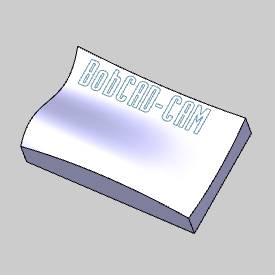
Part 1) Add the Feature
-
In the CAM Tree Manager, right-click
 Machine
Setup and click Mill Multiaxis.
Machine
Setup and click Mill Multiaxis. -
In the Multiaxis Wizard, select Surface and click Project Curves.
-
Click Next>> to go to the Posting settings.
Part 2) Define the Posting Parameters
-
The Work Offset # is automatically set to the value defined in the Machine Setup.
You can change the value here to update the Work Offset # for the feature. -
Click Next>> to go to the Multiaxis Posting settings.
Part 3) Define the Multiaxis Posting Parameters
-
Notice, at the top of the dialog box, that the Use Machine Settings check box is selected.
This means that the Multiaxis Posting parameters for the feature use the same parameters as the machine that is selected in Current Settings.
You can clear the Use Machine Settings check box to define the Multiaxis Posting parameters of the feature separately from the current machine settings.
For this example, no changes are needed. -
Click Next>> to go to the Tool settings.
Part 4) Define the Tool Parameters
-
To define the tool, click Tool Crib.
In the Tool Crib, on the left side, click the Endmill Rough category.
Click Add From Tool Library. -
In the Select Tool dialog box, click anywhere in the row labeled 1/32 Flat Endmill - Standard.
Click OK.
In the Milling Tool Crib, click OK. -
Depending on your Tool Library, a tool holder may already be assigned for the selected tool. A holder is assigned if the Holder Label box displays a label (and the Assign Tool Holder button is labeled Remove Tool Holder). If a holder is already assigned, skip to step 4.
To assign a tool holder, click Assign Tool Holder.
In the Milling Tool Holder Library, in the CAT 40 Holder list, click anywhere in the row labeled 0.25 inch I.D. Arbor CAT 40.
Click OK. -
Click Next>> to go to the Parameters.
Part 5) Select Geometry
-
Under Pattern next to Type, confirm User Defined is selected.
To define the projection curves, click Projection. -
In the Quick Selection group, of the Home ribbon, click
 Pick By Layer.
Pick By Layer.
In the Select Layer dialog box, click Projection Curves, and click OK.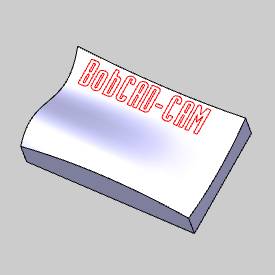
-
To confirm the selection, click
 .
. -
To define the surface being machined, in the Pattern group, click Drive Surfaces.
-
Click to select the top surface as shown next.
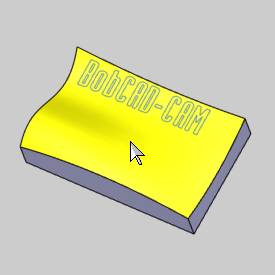
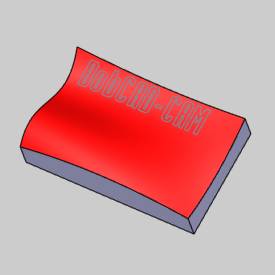
-
Click
 .
.
Part 6) Define the Parameters
-
In the Pattern group, next to Projection Direction, click the down arrow and select Z-axis.
This projects the selected geometry along the Z-axis. -
In the Drive Surfaces Offset box, type -0.01.
This forces the tool into the stock (in-feed) by the specified value. -
At the top of the dialog box, click Link.
-
Click Retracts.
In the Clearance Area group, confirm that the Height is set to 2.00.
This value is automatically set, to the value from the Machine Setup, when the feature is created. (Updating the Clearance Plane in the Machine Setup doesn't update existing Multiaxis features.)
Click OK. -
To calculate the toolpath, at the bottom of the Multiaxis Wizard, click Compute.
The result is shown next. The Projection Curves layer is hidden, and the part is made transparent (press T) to better show the toolpath.
(Because of the negative drive surface offset value, the toolpath is below the surface of the part geometry.)
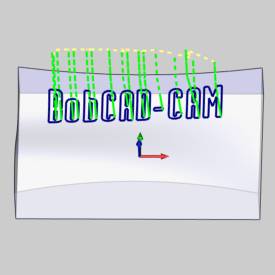
Part 7) Simulate the Program
-
To view program simulation, in the quick access toolbar, of the CAM Tree Manager, click
 .
.
For help with simulation, view Getting Started with Simulation.

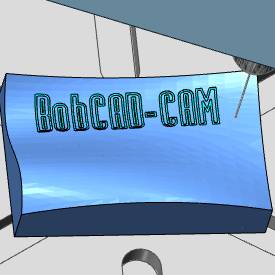
-
To close the simulation, click
 Exit Simulation.
Exit Simulation.
This concludes the tutorial.
